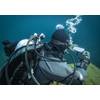Algae Differences Help Corals Fight Climate Change
Corals that build reefs have few defenses against rising ocean temperatures and other effects of global climate change. Among the most important are dense populations of single-celled algae assigned to the dinoflagellate genus Symbiodinium. Several groups of these microalgae are common to coral communities in shallow coastal waters throughout the tropics and subtropics, but few have been designated as separate species even though they are genetically and ecologically quite different.
The authors of an article published in the current issue of the journal Phycologia seek to remedy this nonrecognition of species in the Symbiodinium Clade D group. Using sequences of DNA and other genetic markers, the authors tested their hypothesis that the group was functionally diverse and contained more than one species.
Symbiodinium Clade D is a symbiotic group that appears adapted to withstand the physiological stress of ocean temperature changes. This makes them highly valuable to the corals they live with because they help the corals tolerate extreme temperatures and resist the bleaching mortality that can be devastating to coral reef ecosystems. Research has shown that Clade D has evolved separately from other lineages in the Symbiodinium genus for 10’s of millions of years. However, less work has been done to separate the organisms within the group which makes it difficult to determine their preferred hosts, ideal growing conditions, and how they respond to effects of climate change.
In this article, the authors describe three separate species in detail. Symbiodinium boreum sp. nov. and S. eurythalpos sp. nov. are found in colonies of the zebra coral ( Oulastrea crispata), a stony coral whose extensive habitat loss has landed it on the Red List of Threatened Species, compiled by the International Union for Conservation of Nature and Natural Resources. S. boreum is common in temperate latitudes, such as the northwest Pacific Ocean, whereas S. eurythalpos is found in the tropics of equatorial Southeast Asia. They only overlap in the subtropical center of the coral’s range, but there they sometimes live in the same coral colony. Because of their morphological similarity, genetic tests were needed to assess whether different species existed in the group.
A third species, Symbiodinium trenchii sp. nov., is less tied to a particular type of coral and instead lives in close relationship with various stony corals. It also has a wider range, thriving in the western Pacific and Atlantic Oceans and warm waters in and around the Arabian Sea. Based on population genetic evidence, the three species do not appear to cross-breed.
The authors point out that there are many other species in Clade D with different ecological and geographic distributions waiting to be studied and described.
“Clade D Symbiodinium apparently comprises numerous other separate entities, each exhibiting differences in ecology and physiology,” write the authors. Formally describing them as separate species would aid researchers attempting to understand their influence on their coral hosts and their ability to withstand climate change.
















 February 2024
February 2024



